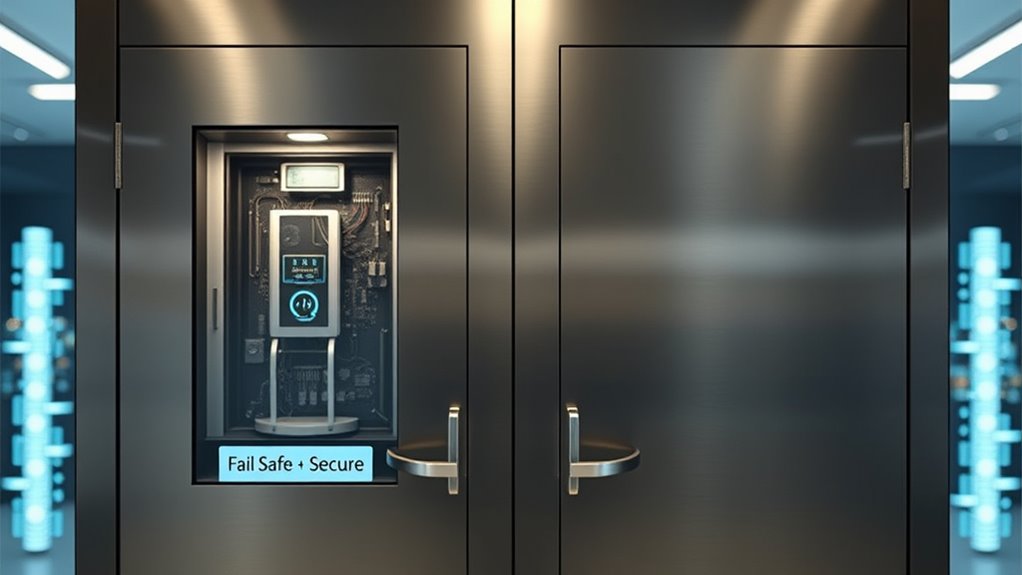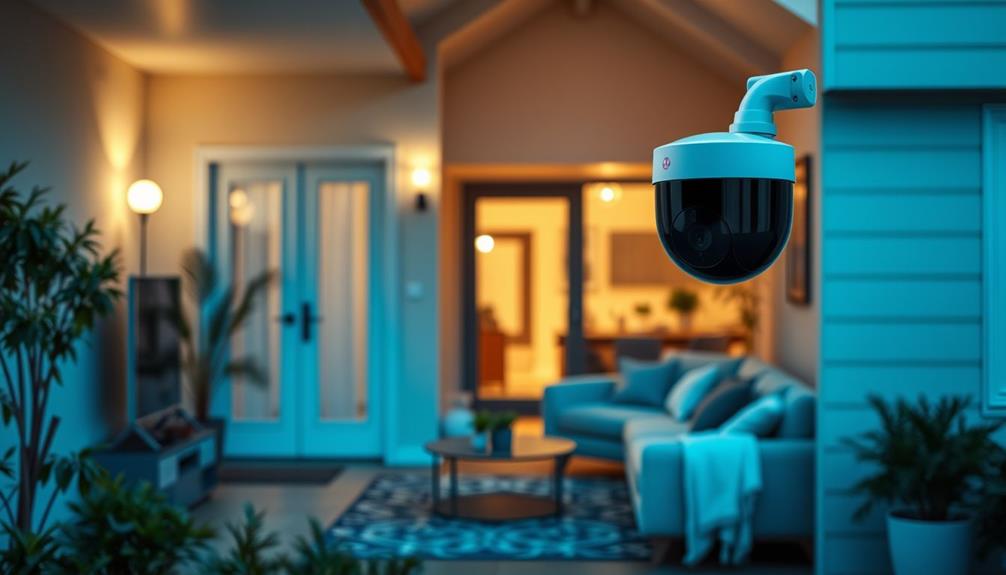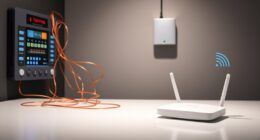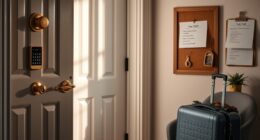When choosing between fail-safe and fail-secure door controllers, consider safety and security priorities. Fail-safe systems open during power outages to ensure quick evacuation, making them ideal for emergency exits and fire safety compliance. Fail-secure systems stay locked, protecting high-security areas, but can hinder egress if not properly managed. Understanding your property’s specific safety regulations and security needs is key—continue exploring to find out which option best fits your requirements.
Key Takeaways
- Fail-safe controllers prioritize occupant safety by unlocking doors during power outages, suitable for emergency egress.
- Fail-secure controllers maintain security by keeping doors locked during power failures, ideal for restricted areas.
- Choose fail-safe systems for life safety compliance and emergency exits; opt for fail-secure in secure zones.
- Consider safety standards, building codes, and environmental factors to select the appropriate system for your application.
- Balance safety, security, cost, and compatibility with existing infrastructure to determine the best door controller type.
Understanding Fail-Safe and Fail-Secure Mechanisms

Understanding fail-safe and fail-secure mechanisms is essential for choosing the right door controller for your security needs. Your access control system depends on how the door responds during a power failure. A fail-safe mechanism ensures the door opens when power is lost, prioritizing safety and emergency egress. Conversely, a fail-secure system keeps the door locked during power outages, maintaining security integrity. The power supply plays a vital role in these mechanisms; a reliable power source guarantees consistent operation, whether in fail-safe or fail-secure modes. When selecting a door controller, consider your security priorities and the type of access control you require. Knowing how these systems respond during power disruptions helps you make an informed decision that balances safety and security effectively. Proper understanding of door controller mechanisms can also help prevent potential security breaches or safety hazards during outages.
Safety Considerations and Building Regulations

You need to guarantee your door controllers meet building codes and safety standards. Emergency egress and fire safety regulations are critical to prevent hazards during emergencies. Ignoring these requirements can lead to legal issues and compromise occupant safety. Additionally, implementing proper signage and safety features ensures compliance with safety protocols and enhances overall security.
Compliance With Building Codes
Ensuring that door controllers comply with building codes is essential for maintaining safety standards and legal adherence. Building codes specify requirements for access control systems, including how door controllers should function to prevent unauthorized entry while ensuring safety. Proper compliance involves selecting systems with reliable power supplies that support fail-safe or fail-secure modes, depending on the application. Your access control system must meet local regulations regarding emergency exits, fire safety, and security. Failing to adhere to these codes can lead to penalties or safety hazards. Verify that your door controllers are certified and tested according to relevant standards. Staying compliant not only protects occupants but also guarantees your facility remains legally compliant and operational. Additionally, understanding emergency exit requirements is critical to ensure quick evacuation in case of emergencies.
Emergency Egress Requirements
Have you considered how emergency egress requirements impact your door controller choices? Safety regulations demand that occupants can exit quickly during emergencies, influencing your access control system design. You must guarantee that doors can be opened effortlessly, even if power is interrupted or the system is active. A fail-safe controller typically releases locks during power loss, aligning with emergency egress standards. Think about:
- A sudden power outage disabling access control but still allowing free exit
- Ensuring power supplies are reliable and backup systems are in place
- Clear signage and hardware that facilitate quick egress in high-stress situations
- Regular testing of access control systems to ensure they function correctly during emergencies
Your choice of door controller must balance security with safety, ensuring compliance with building regulations while enabling swift emergency egress. Properly addressing these considerations helps prevent delays and ensures occupant safety.
Fire Safety Regulations
Fire safety regulations and building codes set strict standards for door controllers to protect occupants during emergencies. These regulations mandate that access control systems must prioritize safe evacuation, requiring fail-safe designs that disengage doors when power is lost or in an emergency. Ensuring a reliable power supply is critical, as any interruption could compromise safety or violate code compliance. Fail-safe controllers are typically favored in life safety applications because they automatically release doors during a fire or power failure, allowing quick evacuation. Conversely, fail-secure controllers keep doors locked for security but may conflict with fire safety regulations if not integrated with emergency systems. Proper sealing mechanisms and air exchange considerations are important for maintaining safety and compliance in fire situations. Always verify that your access control system aligns with local building regulations to maintain safety and legal compliance during emergencies.
Security Implications of Fail-Safe vs. Fail-Secure Systems

Fail-safe and fail-secure door controllers each present distinct security risks that you need to understand. Fail-safe systems prioritize safety, often opening during power loss, which can compromise access control and let intruders in. Fail-secure systems keep doors locked, but if power fails, they may prevent emergency egress, risking safety. The choice impacts your ability to detect intrusion and control access effectively. Imagine:
Fail-safe opens during power loss, risking security; fail-secure stays locked, risking safety during emergencies.
- An intruder exploiting a fail-safe door that releases during outage, gaining easy access.
- A fail-secure door remaining locked during a power failure, trapping occupants.
- The balance between preventing unauthorized entry and ensuring safe egress during emergencies.
- Both systems’ effectiveness can be assessed through 16PF, which provides detailed insights into personality traits that influence decision-making processes related to security systems.
Understanding these risks helps you choose a system that best safeguards both security and safety, aligning with your specific needs.
Common Applications and Use Cases

Both fail-safe and fail-secure door controllers are widely used across various industries, depending on the specific security and safety requirements of each application. In access control systems, fail-secure controllers are common in high-security areas like data centers or vaults, guaranteeing doors lock during power failures. Fail-safe controllers are ideal in emergency exits or life safety applications, where unlocking during power loss allows quick evacuation. Power supply stability is critical; a reliable power source guarantees correct operation regardless of the fail-safe or fail-secure setup. You’ll find these controllers used in commercial buildings, industrial facilities, and healthcare environments. Their application depends on whether safety or security takes priority, and selecting the right system ensures maximum protection and compliance with safety standards. Additionally, understanding the security zone info can help determine the appropriate controller type based on the risk level and operational needs.
Factors to Consider When Selecting a Door Controller

When choosing a door controller, you need to take into account your budget and how much you’re willing to spend. It’s also important to make certain the controller works seamlessly with your existing security systems. Making these decisions carefully will help you select a solution that’s both effective and cost-efficient. Additionally, consider the air quality considerations of your environment, as integrating air purification features can enhance overall safety and comfort.
Cost and Budget Constraints
Budget constraints often play a crucial role in selecting the right door controller, as different options come with varying costs and long-term expenses. When considering your choices, conduct a thorough cost analysis to guarantee you stay within budget limitations without sacrificing security or functionality. Keep in mind that initial costs aren’t the only factor; ongoing maintenance and potential upgrades also impact your total expenditure. Visualize the investment as:
- A sleek, high-tech control panel with premium features
- A budget-friendly model with basic functions but limited scalability
- An upgrade path that might require additional expenses later on
Balancing these options helps you make informed decisions aligned with your financial capacity while maintaining security standards. Prioritize solutions that offer the best value for your specific needs. Additionally, understanding the different types of door controllers, such as fail-safe and fail-secure options, can help you choose a system that best matches your security requirements and budget considerations.
Compatibility With Existing Systems
Choosing a door controller that seamlessly integrates with your existing security infrastructure is vital to guarantee smooth operation and minimize compatibility issues. Focus on door compatibility to verify the new controller works with your current hardware, such as access points, sensors, and locks. System integration is essential; verify that the controller supports your existing security protocols and software. Check whether it’s compatible with your access control management system to avoid costly upgrades or replacements later. Consider communication interfaces like Wiegand, serial, or Ethernet, and confirm they match your setup. Ensuring compatibility upfront prevents delays and additional expenses, providing a reliable, cohesive security network. Additionally, understanding security standards can help ensure your system meets industry requirements and enhances overall safety. Prioritize controllers designed for easy integration to maintain efficient, secure access control across your facilities.
Making an Informed Decision for Your Property

Making an informed decision about your door controllers requires understanding the fundamental differences between fail-safe and fail-secure systems. Consider how each impacts your access control and power supply needs. Fail-safe systems open during power loss, ideal for emergency exits, ensuring safety. Fail-secure systems stay locked, preventing unauthorized access, even if power fails. Visualize:
- A fire alarm triggering doors to open for safe evacuation
- Power outages keeping secure areas locked tight
- Continuous power supply supporting your security priorities
Think about your property’s safety protocols and access control requirements. Will you prioritize emergency egress or security integrity during power failures? Choosing the right system hinges on understanding these vital factors, ensuring your property remains safe and compliant.
Frequently Asked Questions
How Do Maintenance Requirements Differ Between Fail-Safe and Fail-Secure Systems?
You need to understand that maintenance protocols differ substantially between fail-safe and fail-secure systems. Fail-safe systems require regular inspections to guarantee they activate correctly during power failures, emphasizing system reliability. Fail-secure systems demand upkeep to verify that security features stay engaged even during power issues. Your goal is to keep both systems operating efficiently, but their maintenance focuses on different safety and security priorities to ensure peak performance.
Can Both Fail-Safe and Fail-Secure Mechanisms Be Integrated Into Existing Door Systems?
You can integrate both fail-safe and fail-secure mechanisms into your existing door systems, but it requires careful planning. For emergency exits, fail-safe mechanisms guarantee doors open during power failures, allowing quick egress. Fail-secure systems keep doors locked during power failures for security. Depending on your building’s needs, you might need to retrofit or upgrade components, guaranteeing compliance with safety codes while balancing security and safety during power outages or emergencies.
What Are the Cost Implications of Choosing Fail-Safe Versus Fail-Secure Door Controllers?
When choosing between fail-safe and fail-secure door controllers, consider your budget considerations and installation costs. Fail-safe systems might have higher initial expenses due to more complex hardware, but they can reduce long-term safety risks. Fail-secure options often cost less upfront and are easier to install, but may increase liability if safety isn’t prioritized. Weigh these factors carefully to guarantee your choice aligns with your security needs and budget.
Are There Industry Standards Specific to Fail-Safe or Fail-Secure Door Mechanisms?
Imagine a world where door safety standards are as strict as a fortress wall! Industry standards and safety certifications set the bar for fail-safe and fail-secure mechanisms, ensuring you’re protected. Fail-safe doors often meet standards like UL 294, while fail-secure doors follow others like EN 179, depending on your region. Always verify these certifications to guarantee your security system complies with the most rigorous safety requirements.
How Does User Training Vary Between Managing Fail-Safe and Fail-Secure Systems?
You need to tailor user training based on the system type. For fail-safe systems, emphasize emergency procedures and highlight how doors automatically open during power loss, ensuring safety. For fail-secure systems, focus on user awareness of security protocols and proper handling during emergencies, since doors stay locked. Clear instructions help users respond correctly in crises, reducing confusion and enhancing safety regardless of the system’s fail-safe or fail-secure nature.
Conclusion
Choosing between fail-safe and fail-secure door controllers is like selecting a safety net or a vault door—you need the right tool for the right situation. Remember, a fire drill in a skyscraper is no time to find the door won’t open, just as a secure vault isn’t helpful if it traps someone inside during an emergency. By understanding your building’s needs, you’ll guarantee safety and security work hand in hand—like a perfectly choreographed dance.








